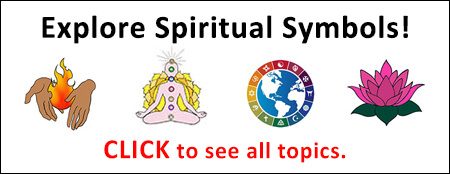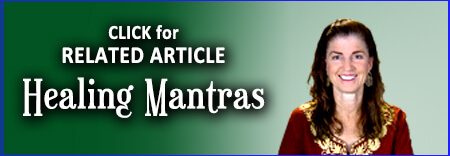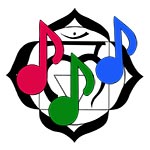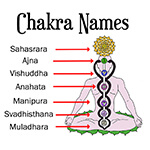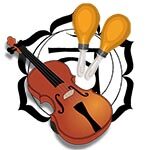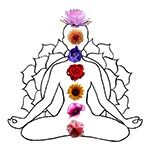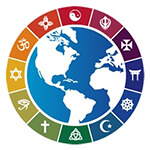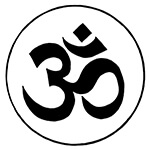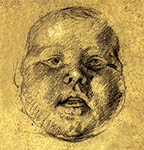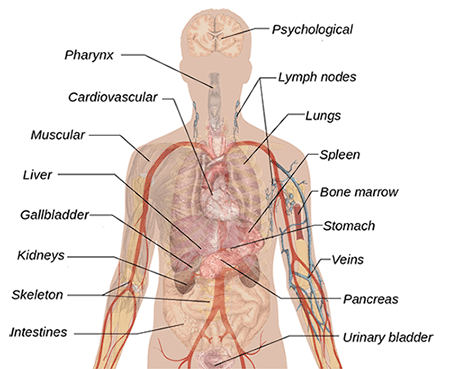
Human Body Diagram Courtesy of Wikimedia Commons
Public Domain, Posted by Mikael Haggstrom
Body Symbolism:
Spiritual Meaning of the Human Body
Body symbolism reveals the inner meaning of each organ and body part. This allows for a greater understanding of health and illness. The spiritual meaning of the body can be a key to healing on all levels: physical, emotional, psychological, and spiritual.
Body Parts and the Mind
Understanding the psychological connection between our physical bodies and our thoughts or emotions gives us a fantastic tool for self-healing. The patterns of our thoughts that have contributed to discomfort or disease can be altered by affirming new thoughts through affirmations or mantras.
Language and Body Symbolism
The meanings associated with different parts of the body are often revealed in our common idioms and colloquial expressions. This correspondence between language and body meaning allows us to use affirmations or mantras with particular healing outcomes in mind.
Power of Sound and Music
When healing affirmations, mantras or positive self-talk are set to music, they can be sung for potentially even more effective results. Singing adds a powerful emotional component that can help us to utilize the connection between the mind and the body for healing.
Table of Contents
Share this page with a friend!
Lower Body: Spiritual Meaning of Body Parts
Bladder Spiritual Meaning
The bladder is an amazing, flexible storage tank. The bladder wall contains three layers of smooth muscle. This pear-shaped organ can extend and shrink as needed. Clearly, the bladder is holding that which the body no longer needs. This is a perfect metaphor for the discernment needed to choose what to retain and what to release in life.
Emotions and the Bladder
When we are angry, we may say that we are “pissed off.” This is literally a reference to the fact that we have a situation where communication is needed! That may be an internal process or an external exchange. Holding onto situations, possessions or people that are no longer serving a positive purpose in your life can appear in the physical body as holding onto excess water or urine.
Feet Spiritual Meaning
The feet represent the willingness to be on earth and engaged in life as in “putting your best foot forward.” In contrast with this, someone who is afraid to rock the boat may be “walking on eggshells.” The feet are our foundation and grounding in life. To have your feet firmly on the ground is to be willing to be on earth and walk your own path.
Symbolism of the Feet
Feet represent our “understanding” of life. Your feet are literally “standing under” your body. To put yourself under the tutelage of another is to be at their feet. For example, many religions refer to sitting at the feet of a spiritual master or deity. Broken or injured legs and ankles can also indicate a conflict concerning the direction you are going.
NOTE: See “A Deeper Look” below for foot problems and healing affirmations.
Hips Spiritual Meaning
The hips move us forward in life: finding one’s place and making the contribution to life that the soul desires. Problems with the hips or a broken hip can be caused by a loss of support or the desire to lean on someone else awhile. You may be resisting forward movement in life.
Celebrating Forward Movement
Interestingly, “Hip, hip, hooray!” is a common way to cheer for those who are successful moving forward in sports, life and business endeavors. Problems with the right hip are related to the masculine side of life or your relationships with men. Difficulty with the left hip is often connected to challenges in your relationships with women or feeling blocked by a feminine presence in your life.
Knees Spiritual Meaning
On both the physiological and emotional levels, the knees are related to bending and flexibility. To “bend the knee” is to recognize the superior rank or knowledge of another. Problems with the knees can be connected to issues of pride and ego. Other causes of knee problems are stubbornness and the refusal to yield when necessary or advisable.
Psychological Meaning of the Knees
The knees are also related to personal “needs.” The left knee is closely related to the needs of the feminine side for both men and women. This could be the need to be appreciated and nurtured. The right knee is related to the masculine side. This might involve the need to be successful in society and to protect others.
Reproductive Organ Spiritual Meaning
The process of reproduction allows us to pass on our genetic materials to future generations. The male and female reproductive organs produce special cells that unite to forma zygote. The zygote grows into an embryo, then a fetus, and finally a independent human being. Accordingly, the uterus in the female represents the home (womb) of creativity. This is a place of nurturing. The male reproductive organs hold the energy necessary to launch a new phase in life or propel a project forward.
Toes Spiritual Meaning
The toes represent the details of the future. Problems with the toes can indicate feelings of tiredness, confusion, anxiety and depression–like a small child who wants to hide from life. You may have the feeling that there are too many events and situations over which you have no control. You may be wanting to give up and run away, expect there is nowhere to run. A positive affirmation for the toes would be: “All details of the future take care of themselves. Change is safe for me.”
Abdomen: Spiritual Meaning of Body Parts
Adrenal Glands Spiritual Meeaning
The adrenals help to regulate the level of energy in the body. They are responsible for the “fight or flight” mechanism when a situation appears to be dangerous or life-threatening. The adrenal glands are small glands found on top of the kidneys. On a spiritual level, these glands relate to joy and excitement about life. Lack of strength in the adrenal glands may be a sensse that the world is not safe.
Hormones Produced by the Adrenal Glands
The adrenals produce epinephrine and small amounts or norepinephrine. These hormones break down glycogen from the liver to quickly increase heart rate and breathing. Blood flow is increased to the muscles to prepare for possible physical exertion. If the adrenals are overused, exhaustion and defeatism can result.
Gall Bladder Spiritual Meaning
The gall bladder is a small organ associated with the liver. The gall bladder releases bile and aids in the digestion of fats. In Oriental medicine, the gall bladder is associated with the wood element. On an emotional level, the gall bladder is connected to the ability to make decisions, movement and flexibility.
Emotions Connections to the Gall Bladder
Problems with the gall bladder can indicate a fear of inappropriate expression, bitterness, hard thoughts, and concern about minor details of the future. Deficiency in the functioning of the gall bladder can result in indecision, timidity, and easily becoming discouraged.
Positive Affirmations for the Gall Bladder
On the positive side, a healthy gall bladder supports courage, initiative and the ability to make changes, decision and decisive actions. Affirmations for the gall bladder include: I release the past joyously. Life is sweet.
Intestines Spiritual Meaning
The intestines serve many critical functions: assimilation, absorption, and elimination. On the symbolic level, these functions relate to both positive and negative thoughts such as the ability to follow ideas through to completion; thinking that you can’t do anything right; or wanting to run away and hide from the world.
Idioms Related to the Intestines
Some of the ways we talk about our intestines that reveal our feelings about this organ include: A gut feeling (intuition); gut check; gut instinct; gut-wrenching; blood and guts (the core of the matter); bust a gut (work hard to an unhealthy level); gut factor (deciding element); gut it out; spill your guts; kick in the gut; no guts, no glory; get your bowels in an uproar; deep in your bowels; intestinal fortitude.
Thoughts Related to the Intestines
Some thoughts that may be related to conditions that need healing in the intestines include the following: Feeling that you are different and alone and that no one understands you. Adamantly defending yourself. Stress and tension from daily life. Deep layers of fear, guilt or grief.
Small Intestines Spiritual Meaning
The small intestine relates to holding onto details and trying to analyze information or experiences obsessively. Focusing on what’s wrong rather than what’s right. Oversensitivity to criticism. Easily hurt or irritated. Difficulty standing up for oneself. Not letting go of that which has served its purpose. Lack of trust in life.
Kidneys Spiritual Meaning
The kidneys are small but incredibly effective organs for filtering blood and keep the body in a state of homeostasis. The kidneys remove waste from the blood: urea, excess water, excess ions and toxic wastes. The kidneys also reabsorb needed substances to return them to the blood. This is a constant exchange to maintain and eliminate substances as needed for optimal health.
Source of Strength
The kidneys are located close to the sacral chakra on the back side of the body. They are viewed energetically as a source of great strength. In many cultures, the lower back and waist are wrapped in a special cloth during the colder months to keep the kidneys warm and support their function.
Liver Spiritual Meaning
The liver is one of the largest organs in the human body, weighing approximately four pounds. The liver has multiple functions crucial for human health. The liver manufactures proteins involved in blood clotting. Cells of the liver destroy certain bacteria and aged white and red blood cells. The liver contains enzymes that break down or store poisons. In addition, the liver stores nutrients, minerals, and vitamins. Finally, the liver produces bile salts that break down fats.
The Liver and Emotions
On an esoteric level, the liver has long been seen as the seat of anger and other primitive emotions. Liver problems can be related to chronic complaining and fault-finding. This may be a refusal to take full responsibility in your own life. Therefore, you are looking for ways to blame others. Changing your thinking patterns can have an immediate and profound effect on the health of the liver.
Lower Back Spiritual Meaning
The lower back is often connected to finances. Economic difficulties can result in tension and pain in the lower back. This can either be a fear of money or a lack of financial support. Feeling overwhelmed or under too much pressure can also cause lower back issues.
Finances and Energy Exchange
By and large, finances are a process of exchange. This may be services or products. Constant worry about paying bills will affect the lower back. Shifting your focus to how you can contribute to others and support yourself can help to reestablish the energy flow in the lower back.
Pancreas Spiritual Meaning
The pancreas represents the ability to handle the sweetness in life. This is literally the ability to balance and process glucose in the body. The pancreas actually has a dual role. On the one hand, the pancreas produces pancreatic juice to aid in the digestion of food. On the other hand, the pancreas uses insulin and glucagon to balance the results of digestion as blood glucose levels. The pancreas is viewed as an endocrine gland because of the secretions it produces.
Pancreas and the Solar Plexus Chakra
The conversion of negativity into advantageous emotions is a superpower of the solar plexus chakra. Having the attitude that the universe is always bringing you the highest possible good is helpful. Even challenges may bring a better outcome than expected or hoped for. You may want to ask yourself, “How can I shift my experience to feel to trust that there is a sweet outcome on the way?”
Pelvis Spiritual Meaning
A broken or injured pelvis shows conflicts related to security, survival, relationships, and sexuality. These issues are directly related to the root chakra. Pelvis injuries can also be a fear of your own feelings. The pelvic girdle is actually made up of two hip bones that meet in the front of the body at the pubic symphysis. In the back of the body, the hip bones meet with the sacrum.
Pelvis and Organs of Elimination
The pelvis contains the organs of elimination and reproduction. The organs of elimination (bladder, colon, rectum) are the most closely connected to the root chakra. The organs of reproduction are more closely related to the second or sacral chakra.
Stomach Spiritual Meaning
Our digestive system is also full of contradictory meanings. Digestion is a process of absorption, nourishment and filtering. The emotional connections are related to honesty, emotional vulnerability, processing the experiences of life, inner power, inner strength and life force.
Problems with the Stomach
Problems with the stomach include the opposite conditions: indigestion, malabsorption, fear of intimacy, insecurity, holding onto toxic feelings, deep-seated fear of not being good enough, worry, concern about and fear of the future. To settle your feelings is to “settle your stomach.” To be highly disturbed is to be “sick to your stomach.” And you don’t want to handle difficult situations “on an empty stomach” (out of energy, strength or sustenance).
NOTE: See “A Deeper Look” below for an extensive discussion of idioms related to the stomach.
Upper Body: Spiritual Meaning of Body Parts
Arms Spiritual Meaning
Arms are related to reaching and holding. A broken arm is related to deep unease about what you are doing. Broken arms can also symbolize not being able to reach out for what you need. You may be doing too much or giving too much.
Fingers Spiritual Meaning
Fingers are related symbolically to handling the details in life. Broken or injured fingers are connected to conflicts in smaller issues. you may be extending too far or reaching out inappropriately.
Hands Spiritual Meaning
A broken hand can be symbolic of a deep conflict over touching or being touched. Hands also represent how you are handling life or being handled. You may be resentful at giving someone else a hand (assistance) without receiving anything yourself. You may be letting things slip through your hands. On the other hand (no pun intended), you may be grasping life too tightly.
Hand and Wrist Injuries
A broken hand can be suppressing a desire to punch someone. A broken wrist can be a desire to limit or avoid certain activities. You may have a deep conflict over what you are doing or what is being done to you.
Heart Spiritual Meaning
In the spiritual dimension, many traditions believe that the spark of life resides is an inner chamber associated with the heart. In the Western religious tradition, this inner chamber is called the inner castle or secret chamber of the heart. In the Eastern tradition, this inner heart is referred to as Brahma’s Cave. The ability to retreat into the inner chamber of the heart may be a critical skill in the fast-paced modern world.
Emotional Significance of the Heart
Traditions around the world place great importance on the significance of the heart. Many believe the heart has emotional significance as well as spiritual meaning. Some researchers believe that the heart has sensory functions as well as the mechanical function of pumping blood. Studies have shown that the heart reacts even more quickly than the brain to strong visual stimuli such as highly positive or negative visual images. The heart may be telling the brain to react rather than the other way around.
Lungs Spiritual Meaning
The exchange of gases necessary for life takes place by diffusion across the alveoli and the capillary network in the lungs. Estimates are that the lungs contain over 300 million aveoli with a total surface area of 753 square feet (70 square meters). This provides a large surface for the exchange of oxygen and carbon dioxide.
Lungs and the Fire Breath
God is associated with the breath, fire and the wind in many traditions. The idea that God breathes life into animate form is also a common theme. In Christianity, the Holy Spirit is an undifferentiated power of God often referred to as a sacred breath. In Eastern traditions, the practice of pranayama (breath control) is integral to spiritual advancement.
Lung and Rib Injuries
To break your ribs indicates a conflict between emotional vulnerability and protecting yourself. Broken ribs or damaged lungs can also indicate a refusal to breathe in life deeply.
Neck Spiritual Meaning
The neck is the physical separation between the mind and body. Problems with the neck may indicate that you feel required to live a life that is not in keeping with your own vision for yourself. The mind and body have become separated.
Suffering a Broken Neck
A broken neck indicates a severe disconnect between the body and the mind. Injury to the neck can also indicate a tendency towards cutting off or strangling all feelings. A broken neck can also indicate a sense of not knowing where to turn in life.
Problems with the Neck
A tight neck also is a way to keep from feeling the responses of your body to life. A stiff neck may indicate resisting the views of others around you. A healthy neck represents your right to commit fully and participate fully in the life of your choosing. The neck is your right to be on earth, to belong and to create a situation where you feel at home.
Shoulders Spiritual Meaning
The spiritual meaning of shoulders can be drawn from the growing scientific evidence collected through somatic therapies and health psychology. This research as well as anecdotal evidence connects aspects of the body with specific thought patterns. This work reveals associations between illnesses or injuries of specific parts of the body and emotional states.
Psychology of the Shoulders
Difficulties with the shoulders may indicate that you are living a life of duty and obligation. Pain in the shoulders may indicate a block in your expression of love towards others (hugging, reaching out). Hunched shoulders can be overwhelm by the burden of life. Shoulders that are raised or pulled back can project strength but hide feeling of inadequacy or show where feelings are being held back.
NOTE: See “A Deeper Look” below for historic, religious and cultural meanings of the shoulders.
Skin Spiritual Meaning
The skin is our clearest boundary between ourselves and the environment. Problems with the skin can be connected a lack of feeling safe in your own self-expression. The skin is often a concern during the teenage years when physical and hormonal shifts have a significant impact on the sense of self.
Thyroid Spiritual Meaning
The thyroid is associated with the breathe and the rhythm of life. The thyroid is related to the throat chakra and the ability to speak up for oneself. Trapped anger (unspoken words) are often held in the thyroid. The thyroid gland plays a major role in metabolism, growth and vital body functions such as heart rate and body temperature.
Mantras and the Thyroid
Chanting is an ideal tool for supporting the health of the thyroid gland since the vibrations of chanting and singing pass directly through the thyroid. A video about restoring proper functioning for the thyroid called “My Healing Journey: Mantras, Money and the Thyroid” can be found in the Throat Chakra Meaning article.
Tonsils and Throat Spiritual Meaning
The spirtual meaning of the throat is related to what you are taking into yourself from the external world. What have you swallowed that was frightening or frustrating? What reality cannot be filtered by your immune system? Children or adults who are unhappy, do not understand what is happening around them or have no control over events may develop inflamed tonsils.
Trachea and Esophagus Spiritual Meaning
The trachea is also called the windpipe. This tubular passage is the airway connecting the mouth with the lungs. The trachea is a combination of cartilage, muscles and elastic tissue. The esophagus is a collapsible, muscular tube behind the trachea. The esophagus transports food to the stomach. This is the organ that helps us to swallow our food.
Symbolism of the Esophagus
Problems with the esophagus can be related to “swallowing” grief, anger or hurt. Acid reflux (also known as “heartburn”) is a common disorder that affects the esophagus. Some studies suggest that more than 15 million Americans experience heartburn symptoms every day.
Vocal Chords Spiritual Meaning
The key voice apparatus is the area in the larynx called the vocal chords. The vocal chords are ligaments shaped like a “V”. These ligaments vibrate when we speak or sing. The vocal chords are about as long as the lines that would be required to draw a triangle on the front of a penny. The vocal chords also vibrate about the depth of the penny. On the psychological or spiritual level, “losing your voice” may result from refusing to communicate, feelings powerless, or pushing yourself beyond your capacity.
Head: Spiritual Meaning of Body Parts
Brain Spiritual Meaning
The brain has long been viewed as the seat of learning and intelligence as well as the seat of enlightenment. Studies now show that the brain retains elasticity far better than previously thought. Lifelong learning and exercise help to keep the brain functioning at an optimal level into the final decades of life. The brain is like a central control system similar to a switchboard or computer.
Spiritual Power of the Brain and Crown Chakra
The energy of the crown chakra is usually represented as yellow or white. This is indicated in the halos around the heads of saints in Western iconography. In the east, the lotus is a revered symbol for the gentle opening of consciousness, petal by petal.
Brain and Skull Injuries
A cracked or broken skull is related to the need to expand and grow from within or the need to be free from restrictive, external circumstances. An injury to the skull can also show a desire for deeper insight and enlightenment.
Cheek Spiritual Meaning
Cheek meaning is revealed clearly in the language that we use to describe our bodies. A single part of the body can be heavily laden with many different meanings. And sometimes the meanings are highly amusing as well. This is particularly true of the cheek: the fleshy part of the face on either side of the nose between the eyes and ears. Learn about cheek idioms and read full article on Cheek Meaning.
Chin Spiritual Meaning
To “take it on the chin” is to stand up to something adverse or unfair. The chin can take the full brunt of criticism or adversity. This alludes to a blow on the chin in boxing or fighting. Taking it on the chin can also mean not to complain when bad things happen. A trembling chin shows emotions that are being held in check, especially grief or sadness.
Ears Spiritual Meaning
The ears not only allow us to access the world of sound around us, but also serve a crucial role in balance and equilibrium. The middle ear is air-filled and contains tiny bones that transfer vibrations to the fluid-filled inner ear. The ability to hear external noises is closely linked to the ability to hear one’s own inner voice. Turmoil or conflict around you can result in ear infections or other disturbances in the ability to hear.
Watch over 200 videos on our YouTube channel!
Eyes Symbolic Meaning
Our eyes literally represent our vision of the past, present and future. The eyes are the most mystical and emotion-laden organ in the body. The ability to see clearly is our most cherished sense. Accordingly, the eyes are deeply affected by our emotional and psychological world. On that level, problems with the eyes reflect the inability or fear of seeing what is in our world.
Spiritual Meaning of Vision Problems
Near-sightedness indicates comfortability with the future. Near-sightedness can be related to fear of a parent by a child. Far-sightedness may be an attempt to not see what is happening now and to escape into the future. Releasing the trauma locked in the eye muscles can restore healthy vision.
Face Spiritual Meaning
Clearly, the face is the identity that we show to the world. The idioms related to the face are numerous: “Put on a good face. Face the music. Face your problems. Do an about face.” To break or injure facial bones indicates a conflict between your outer appearance and inner self. Injury to the face breaks the mask that you show to the world.
Hair Spiritual Meaning
Many cultures around the world, from Native Americans to Sikhs, believe that hair has a special significance. Cultural beliefs about our hair and how it can affect us go back as far as recorded history. Some ancient cultures believed there is power in uncut hair. Long hair on a man was attached to a cultural as well as a ceremonial significance.
Meaning of Hair in Ancient Cultures
For many cultures, long hair was a sign of courage and nobility. Cutting hair in some cultures meant cowardice, or mourning. Other cultures simply valued the way a man looked with a handsome complexion and long, dark hair. In Ancient Greece, long male hair was a symbol of wealth and power, while a shaven head was appropriate for a slave.
NOTE: See “A Deeper Look” below for an extensive discussion of the spiritual meaning of the hair.
Hypothalamus Spiritual Meaning
The hypothalamus controls many functions related to homeostasis in the body. The hypothalamus works closely with the secretions from the pituitary gland. The hypothalamus receives sensory input from the body’s internal organs and controls the autonomic nervous system.
Mantras and the Hypothalamus
The hypothalamus plays a key role as the intermediary between the nervous system and the endocrine system. Like other organs located in the head or brain, the hypothalamus is affected by the vibrations of singing and sacred toning. The energy of mantras resonates through the skull, accelerating spiritual sensitivity through activating glands in the brain.
Mouth Spiritual Meaning
Mouth meaning taps into the entire world of emotions and self-expression. The mouth is possibly the most psychologically conflicted feature of the face. The mouth is a central focus for both receiving and giving pleasure and pain. We use the mouth to take in food and drink, to praise and curse, to kiss and spit, to sing and to moan.
Pineal Gland Spiritual Meaning
The name pineal comes from the Latin pinea or pinus, meaning pine cone. Representations of the pineal gland are used symbolically in art of the Sumerians, Egyptians, Indonesians, Greeks, Romans and Babylonians. Some traditions say that the soul enters and leaves the physical body at birth and death through the pineal gland.
Pineal Gland and Spiritual Vision
In most people, the degeneration of the pineal gland begins at the age of six or seven and continues until puberty. Some sources believe this is why children over the age of six or seven have a diminished ability to sense the spiritual world. They may no longer have “invisible playmates” or remember what happened “before they were born.”
Pituitary Gland Spiritual Meaning
The pituitary gland secretes oxytocin and vasopressin. Oxytocin is the “bonding” hormone, present when a mother first nurses a newborn baby. Oxytocin is also released in positive social situations. The second type of hormones released by the anterior pituitary gland are growth hormones. The pituitary gland is referred to as the “master gland” because it controls the secretions of so many other glands.
Relationships and Hormones
Mastering relationships is connected to the ability to bond with others in a healthy way. This is one of the first steps on a spiritual path. Whether one chooses to be cloistered from the world or deeply embedded in society, there are always relationships to manage. Understanding the connection between the physical and spiritual aspects of relationships can accelerate this process.
Chakra-Related Articles
Systems of the Body
Endocrine System Spiritual Symbolism
The endocrine system produces hormones that control the internal environment of the body. This affects our health from the cellular to the organ level of organization. Hormones are crucial in growth, the development of sexual characteristics and behavioral regulation.
Hormones operate primarily through a negative feedback loop, triggered by levels of the hormone in the body. The endocrine system consists of the hypothalamus, pituitary, pineal, thyroid, parathyroid, thymus, adrenal glands, pancreas and gonads. Managing your emotions is closely linked to this system. The hormones are deeply affected by thoughts and emotions. They are sometimes viewed as the carrier of spiritual energy in the body.
Muscular System Spiritual Symbolism
The muscles are the first system in the body to react to stress. As muscles are tightened, movement is limited, and inflexibility results. When the basic survival needs connected to the root chakra (food, shelter, and acceptance) are not being met, chronic muscular tension can result.
The Root of Muscular Stress
Holding tense muscles can be a way to protect yourself. You may feel overwhelmed and out of control. Emotional paralysis and physical tenseness may go hand in hand. Addressing the core issues of the root chakra on all levels can help to release this tension.
Finding Release for the Muscular System
Prayer and meditation are helpful for centering. You may also want to take stock of your situation on a pragmatic level and look for practical solutions to attaining a higher level of security in your life. A new job, increased education or training, or relocation may be options to consider.
Nervous System Spiritual Symbolism
The nervous system controls and integrates all of the other systems of the body. The nervous system consists of the brain, spinal cord, cranial nerves, peripheral nerves, and the sensory and motor structures of the body. The two major branches of the nervous system are the central nervous system and the peripheral nervous system. These are the physical paths of communication in the body.
Sensitivity of the Nervous System
The nervous system is related to a whole host of conditions that are often hard to diagnose and hard to treat. The nervous system may be highly sensitive in those who are attune to spiritual vibrations. The crown chakra can also be compromised by substances that affect consciousness such as psychedelics, prescription drugs, and environmental toxins.
Skeletal System Spiritual Symbolism
Each of the body’s systems have their own symbolic meaning. Within that context, aspects of the systems indicate where mental or emotional conflicts may exist. The skeleton serves as the framework and structure for our lives. We depend on the strength of our skeleton for everything we do. The skeleton represents security, safety, trust and belonging. For these reasons, the skeleton is associated with the root or base chakra. Learn more in the article Root Chakra Meaning.
The Skeleton and Core Beliefs
The skeleton is the hardest and densest form of tissue in the human body. Therefore, the skeleton is connected to our deepest level of psychology, emotions and spirituality. Breaking a bone or developing a bone disease is an opportunity to look at core beliefs, the deepest levels of inner strength and security and the very purpose and reason for existence.
Circulatory System Spiritual Meaning
The circulatory system is composed of three branches: the systemic circulation (body), the pulmonary circulation (lungs), and the cerebral circulation (brain). Another temporary circulation system called the fetal circulation system exists temporarily in pregnant women.
Movement of Spiritual Energy
The circulatory system is a wonderful metaphor for the circulation of energy throughout the entire body as well as the chakra system. The heart is often recommended as a focus for attention during spiritual practices including mantras.
A Deeper Look at Body Meaning
Foot Problems and Healing Affirmations
To break a foot indicates conflict about the direction you are going in life. A broken foot can also mean that you are letting someone else take advantage of you (not putting your foot down). Broken or injured toes can be the result of conflicts in immediate issues and the details of life. Toes and fingers have many similarities. You may be extending too far in life.
Emotional Connections to Foot Issues
Problems with the feet can indicate corresponding emotional issues:
- Feet that are knotted upward indicate someone who is afraid to disturb those around them.
- Feet pointed outward indicate confusion about a direction in life.
- Feet pointed inward indicate shame and resistance related to sexual and spiritual maturity.
- Injury or disease of the feet can indicate concerns about security and lack of solid contact with the earth and the meeting of physical needs.
- Injury to the feet can be blocking the desire to kick someone.
- Problems with the feet may indicate a fear of the future and stepping forward in life.
- Cold feet indicate withdrawal from an emotional situation.
- Swollen feet are holding frustration about your direction in life.
Affirmations for Healing the Feet
Affirmations for the feet include: I move forward in life with joy and ease. My new direction in life is safe for me. My life is supported with abundance and loving relationships.
Hair Symbolism and Cultural Meaning
Hair Symbolism in Europe
In the European middle ages, shorter hair often signified servitude and peasantry, while long hair was often attributed to freemen. The Gaelic Irish took great pride in their long hair, and a person could be heavily fined for cutting a man’s hair short against his will. Before World War I, men generally had longer hair and beards.
Connection Between Hair and Physical Strength
In ancient China and Korea, hair was regarded as a precious legacy from parents. Most people would never cut their hair after they became adults and cutting off one’s hair was a penalty for minor crimes. In the Old Testament, the Nazirites would go for long periods of time without cutting their hair to show devotion to God. According to the Bible, Samson is one example. Samson’s strength depended upon his refraining from cutting his hair.
Hair as a Sensing Organ
Rumors are that during the Vietnam War, American Indian scouts known for their incredible tracking abilities were recruited by the US military. Once they were sent through boot camp, their abilities were critically diminished. In an effort to discover why they could no longer sense the enemy or prepare for danger, investigators eventually narrowed their research down to their need for long hair as a sensing device.
Hair and the Environment
Apparently hair is not just for endless primping and fashion. Human hair may function similarly to cat whiskers, a type of feeler or antennae that transmits information to the limbic system, brainstem and neocortex. This includes head hair, body hair and facial hair in men. Cutting your hair may actually numb the senses and reduce awareness of the environment.
Long Hair and Religion
Long hair and beards have been part of many religious traditions. Ancient peoples cut their hair only as an extreme sign of mourning, or a way to increase hygiene in armies. Long hair was usually cut when people were enslaved as an outward sign of their loss of power.
Ayurvedic Beliefs About Hair
In the Ayurvedic system, hair is seen as an extension of the etheric spine, taking in life force or prana to increase our vitality and intuition. When left to grow without cutting, the length of hair will be different for each individual. Like the skin, the hair is said to absorb vitamin D as well as phosphorus and calcium. The natural oils in hair assist in this process. Ideally, washed hair will be dried in the sun.
Hair of the Rishis
In India, wise men or Rishis coiled their long hair at the crown of their head to energize the pineal gland and mental faculties. This coil helped channel the energy of the sun during the day. At night, the hair is down or loosely braided. Wooden combs (which do not create static electricity) were recommended to keep the hair healthy.
Hair as a Record of Life Experiences
Another interesting aspect of hair is the idea that long hair is associated with maturity and with accepting the order of the universe. Children are generally born with very little hair. As they grow, their hair is part of the record of their life experiences.
Spiritual Significance of Hair
Some believe that hair holds emotional energy. As an adult, long hair may be a way to take our place sensitively in our environment. It may be a sign of humility to accept that there is a reason for our hair even if we do not fully understand its significance. As Yogi Bhahan said: “Your hair is not there by mistake. It has a definite purpose, which saints will discover and other men will laugh at.”
Resources:
http://www.rense.com/general95/hair.htm
http://nurofeg.blogspot.com/2012/04/power-of-hair.html
https://www.quantumbalancing.com/spiritualhair.htm
Shoulder Meaning: Historic and Popular Culture
The shoulders represent the ability to carry our experiences and responsibilities in life. If we are so busy with what we “should” do, have too much to do, or are caring for others with little time for ourselves, then our shoulders can become tense and rigid. A stiff or frozen shoulder may symbolize resistance to the pressure that life is exerting on you to perform and an unwillingness to let others or life itself help us to carry the burden.
Idioms Related to the Shoulders
Idioms and language connections to the shoulders include the following: he carries the weight of the world on his shoulders; a chip on his shoulder (easily competitive or angered); a shoulder to cry on; put your shoulder to the wheel, square your shoulders; she’s got broad shoulders; a good head on his shoulders; shrug your shoulders; gave him the cold shoulder; and rub shoulders with others.
Meaning of Shoulder Injuries
To break a shoulder shows that you are carrying too much weight and responsibility. Other types of shoulder injuries such as a torn rotator cuff also indicate bearing burdens that are not rightfully your own. A broken shoulder can symbolize not expressing your real needs or that there is something you’d rather not be doing. You may be reaching out to the wrong person. A shoulder injury may also indicate a resistance to the pressure to perform.
Shoulder Spiritual Meaning in World Religions
The spiritual meaning of the shoulders is also revealed in various religious traditions. In the Christian Bible, the shoulder signifies all power. The shoulder includes the power of the hand and the arm. To serve God “with side and with shoulder” (Ezekiel 34:21) means to serve with all one’s soul and all one’s might. To rend a shoulder means to be deprived of all power. To “turn a stubborn shoulder” (Zechariah 7:11) means to resist with all one’s might.
Christian Spiritual Meaning of the Shoulders
Prophecies concerning Jesus as the coming Messiah make reference to his role as a counselor and advisor: “the government shall be upon His shoulder” (Isaiah 9:6). There are also New Testament references to the “lost sheep” being carried on the shoulder of the Good Shepherd.
Shoulder Symbolism in Hinduism
In the Hindu tradition, there is a clear distinction between the left and the right. Women always sit to the left of the male (off of his left shoulder). In specific rituals and ceremonial worship, a woman may be off the right shoulder of her husband.
Shoulder Spiritual Associations in Baha’i
In the Baha’i faith, negative and positive forces are represented by angels and devils. These beings symbolically sit on the right and left shoulders, respectively. Their whisperings influence choices for good or ill.
Islamic Spiritual Meanings of the Shoulders
According to Islam, each individual has two angels: one on the right side and one on the left. The angel on the right records good deeds. The angel on the left records bad deeds. These records will eventually be part of the judgment of the soul.
Shoulder Metaphors in Music
There are many songs in the repertoire of sacred music around the world about laying down our burdens. We can symbolically give our burdens over to a higher power such as a deity or life itself, potentially alleviating physical problems with the shoulders. Many mantras emphasize surrender to a spiritual teacher or a representative of God. In any of these situations, a mantra can be found or created that allows us to release our feelings into the physical world and potentially transform our physical bodies in a positive way.
Affirmations for Healing the Shoulders
A basic affirmation for the shoulders is : “I carry my experiences easily. My burden is light.” Other affirmations include: “I choose to participate in life in ways that are right for me. I let go of all situations that are not serving my spirit. I have enough time for activities that bring me joy and freedom. I express love in ways that increase my joy. “
Stomach Idioms and Healing Thoughts
Because of the many central functions of the stomach, the idioms and language related to the stomach are highly varied. Someone who is honest and emotionally vulnerable may be said to “spill their guts.” We’ve all got “gut feelings” in “the pit of our stomach” that warn us of impending danger. To go “belly up” is to go bankrupt. When you want to have more than you can handle, your “eyes are bigger than your stomach.”
More Stomach Metaphors and Idioms
To “bust a gut” is to strain yourself, usually unnecessarily. If you can’t let go of a problem or agitation about a situation or person, it’s “eating you up.” If you are constantly thinking about your problems, you are “contemplating your navel.” To be nervous is to “have butterflies in your stomach.” You may have a “weak stomach” (easily disturbed) or a “strong stomach” (ready to handle most things) or a “cast-iron” stomach (can handle anything).
Language Related to the Stomach
If you dislike someone, you just “can’t stomach them.” And when you really dislike someone, you “hate their guts.” That’s pretty telling right there. We don’t hate their kidneys or their forearms or their shoulders, we “hate their guts.” The guts are the core of the person, both literally and symbolically.
Healing the Stomach and Gut
A key to healing the gut is learning to be compassionate and loving without getting subjectively involved in the reality or suffering that you are witnessing. Learn not to take on another’s suffering when seeking to be of assistance.
Symbolism-Related Video Shorts
Watch over 200 videos on our YouTube channel!
Mantras, Yantras & the Spiritual Body
Mantra Yoga is a practice that unites the body and soul. Sound is a conduit between the world of the spirit or energy and the world of the earth. There seems to be a fairly direct conversion of energy into matter. Quantum physics is demonstrating that particles and waves merge and shift into one another constantly.
Hans Jenny and Cymatics
The work of Hans Jenny in the science of cymatics demonstrates that forms are created by various tones and sounds. There is a clear congruency between sound and geometric forms. This directly ties into the practice of both mantras and the use of yantras or sacred geometry. When we speak, and especially when we chant or sing, we may be creating geometric forms in our own bodies and in the matter around us. This is quite a science and a lifetime study.
The Incorruptible Spiritual Body
There is also a concept in Christianity that one day we will have an eternal body: “this corruptible must put on incorruption” [1 Corinthians 15: 53]. This is called the “body glorious” or the “body celestial.” The same concept exists in many religions in different forms: the idea that there is an eternal body that we can create or receive.
Mantras and the Physical Body
Mantras are a form of self-investigation. What feelings arise and what is the impact on the physical body? When you chant do you feel spacey or grounded or uncomfortable or elated? These may be keys to evaluating your own psychological and emotional states. In the Ayurvedic tradition, specific mantras are used for various parts of the body. Learn more in the article Healing Mantras.
Research and Science: Mind-Body Connection
Research has been done by scientists like Candace Pert that demonstrates how thoughts are converted to chemicals in the body. In the book The Holographic Universe by Michael Talbot, he relays reports of people with multiple personalities whose physical forms change when they shift from one personality to another. There are records of people whose eye color, scars, eyesight and conditions like diabetes appear and disappear when they are existing as one personality versus another. That is amazing!
Impact of Sound on the Body
Perhaps the body is far more fluid than we have thought in the past. For example, the human lymph system is a critical part of health and wellness. Anything that is fluid is instantly affected by sound. Sound is a bridge that unites the physical and the spiritual. A practice like chanting that involves the emotions, the mind, the heart and the physical body may allow people to transform themselves into more glorious beings on one level or another.
The Body and the Spiritual Path
Ultimately a dedicated spiritual path, including whatever practices appeal deeply to you, can lead to a harmonious relationship between the body and soul. Maybe there are multiple answers to the long-standing question of solving the problems of old age, disease, and death. The use of mantras and affirmations is a path that can work on many levels while we continue to living in the modern world and fulfill various responsibilities.
More Symbolism Articles
Pioneers in the Field of Body Symbolism
For several decades there have been forerunners in metaphysics and psychology insisting that we recognize the importance of attitudes, emotions and beliefs in health and wellness. These include Louise Hay, Dr. John Sarno, Steven Ray Ozanich, Deb Shapiro, Joe Dispenza, Inna Segal, Bernie Siegel and more. I am grateful for the work of each and every one of these brave pioneers.
Meaning of Specific Body Parts
Some of these experts have mapped out distinct connections between personality patterns, body symbolism, and health conditions. My work has been to extend this by adding the practice of mantras to healing the body and mind. By understanding the specific symbolic meaning of an aspect of the human body, you can consciously direct healing energy to whatever body part is in need. Studying the works of the authors and experts above can be a fantastic step towards taking grater responsibility for your own level of health and wellness.
Watch over 200 videos on our YouTube channel!
Author’s Story: Healing a Chronic Injury
“I woke up suddenly in the middle of the night nearly a decade ago. From somewhere the thought came to me: “I will put my laws in their inward parts, and in their hearts I will write them.” This Biblical quote (Jeremiah 31:33) was only vaguely familiar to me. All the same, in that instant I knew that everything I needed to know to heal myself was literally written in every cell, organ and limb of my physical body. My physical body was reflecting my thoughts and experiences.
As others have said before me, biography had become biology. The invisible had become visible. I could read the script of my life‒past, present and the trajectory for my future‒in my physical form. The words and sounds that we choose to vocalize and those that we sing are creating and recreating us constantly. This is one of the reasons that I generally prefer chanting as a spiritual practice when compared with meditation or silent prayer. Sound affects matter. And that matters to me.
Unfortunately, our thoughts, feelings, beliefs, words and lifestyle choices are sometimes the weapons of our own chosen self-destruction. If we accept the premise that God, as the energy of life, is literally with us in every breath and heartbeat, we need only read the messages written in our bodies with true honesty and courage to know how to heal ourselves. This does not discount medical attention but is an adjunct to reasonable health measures.
This is not to judge ourselves or others for maladies of the body or soul, but a way to have compassion for ourselves and others. The video above is my own story of healing a chronic injury and how I used emotional release to regain greater mobility.”
References: The Divided Mind by Dr. John Sarno; The Great Pain Deception by Steven Ray Ozanich
Watch over 200 videos on our YouTube channel!
Author’s Story: Healing My Back with a Painting
“I had a very interesting and unusual experience with a healing painting several years ago when I had a chronic back problem. At the time I was involved in a major project with a friend. Just when I thought we were getting things rolling, the situation in his life changed. He backed out and I continued on alone. Right around that time, I noticed that my back was hurting.
I had to be careful not to stretch too far or bend too far forward. I had started doing yoga, but I didn’t remember injuring myself during yoga. I didn’t remember injuring myself at all. One day I just discovered that I had pain in my lower back. Little did I know that a semi-abstract piece of art would become a healing painting for me. The video above tells the story of this experience.”
Author Kathleen Karlsen
Kathleen Karlsen is a musician, artist, writer and speaker. She is the author of two books (Flower Symbols and Vocal Medicine) and over 200 articles. Kathleen, her husband Andrew, and their five children live in Bozeman, Montana. More about Kathleen Karlsen.

